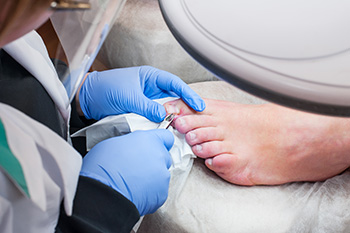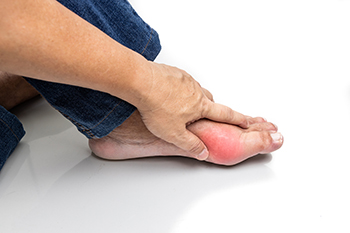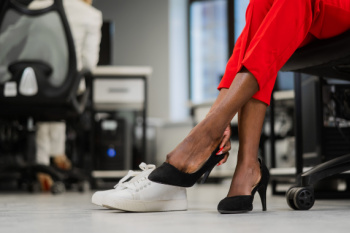Items filtered by date: July 2024
Surgical Procedure for an Ingrown Toenail

An ingrown toenail, a common and often painful condition, may require surgical intervention when conservative treatments fail to provide relief. The surgical procedure, known as partial nail avulsion, involves numbing the toe with a local anesthetic. Once numb, the podiatrist carefully removes the portion of the toenail that is ingrown, ensuring to leave the healthy nail intact. In some cases, the nail bed may also be treated to prevent future ingrowth. The procedure is typically quick, taking only a few minutes, and patients can often return home the same day. After surgery, it is essential to keep the toe clean and dry, following any post-operative care instructions provided by the podiatrist. If you have an ingrown toenail that is causing you chronic pain and discomfort, it is suggested that you consult a podiatrist who can determine if this type of surgery is right for you.
Foot surgery is sometimes necessary to treat a foot ailment. To learn more, contact one of our podiatrists of Itasca Foot & Ankle. Our doctors will assist you with all of your foot and ankle needs.
When Is Surgery Necessary?
Foot and ankle surgery is generally reserved for cases in which less invasive, conservative procedures have failed to alleviate the problem. Some of the cases in which surgery may be necessary include:
- Removing foot deformities like bunions and bone spurs
- Severe arthritis that has caused bone issues
- Cosmetic reconstruction
What Types of Surgery Are There?
The type of surgery you receive will depend on the nature of the problem you have. Some of the possible surgeries include:
- Bunionectomy for painful bunions
- Surgical fusion for realignment of bones
- Neuropathy decompression surgery to treat nerve damage
Benefits of Surgery
Although surgery is usually a last resort, it can provide more complete pain relief compared to non-surgical methods and may allow you to finally resume full activity.
Surgical techniques have also become increasingly sophisticated. Techniques like endoscopic surgery allow for smaller incisions and faster recovery times.
If you have any questions please feel free to contact our offices located in Itasca and Hoffman Estates, IL . We offer the newest diagnostic and treatment technologies for all your foot and ankle needs.
Managing Your Non-Diabetic Foot Infection

Non-diabetic foot infections can arise from various sources, including cuts, puncture wounds, or fungal infections. Symptoms often include redness, swelling, and pain, potentially accompanied by drainage or fever if severe. Causes range from minor injuries to exposure in moist environments. Immediate treatment involves cleaning the affected area with mild soap and water, applying an antibiotic ointment, and covering with a clean bandage. Keeping weight off the affected foot and elevating it can aid healing. It is important to monitor for worsening symptoms or signs of infection. For persistent infections, particularly those spreading or not responding to initial care, seeking prompt evaluation by a podiatrist is key. This type of doctor can assess the infection's severity, provide stronger antibiotics or drainage procedures if necessary, and ensure comprehensive care to promote healing and prevent complications. If you are experiencing these symptoms, it is suggested you schedule an appointment with a podiatrist for specialized treatment.
Wound care is an important part in dealing with diabetes. If you have diabetes and a foot wound or would like more information about wound care for diabetics, consult with one of our podiatrists from Itasca Foot & Ankle. Our doctors will assess your condition and provide you with quality foot and ankle treatment.
What Is Wound Care?
Wound care is the practice of taking proper care of a wound. This can range from the smallest to the largest of wounds. While everyone can benefit from proper wound care, it is much more important for diabetics. Diabetics often suffer from poor blood circulation which causes wounds to heal much slower than they would in a non-diabetic.
What Is the Importance of Wound Care?
While it may not seem apparent with small ulcers on the foot, for diabetics, any size ulcer can become infected. Diabetics often also suffer from neuropathy, or nerve loss. This means they might not even feel when they have an ulcer on their foot. If the wound becomes severely infected, amputation may be necessary. Therefore, it is of the upmost importance to properly care for any and all foot wounds.
How to Care for Wounds
The best way to care for foot wounds is to prevent them. For diabetics, this means daily inspections of the feet for any signs of abnormalities or ulcers. It is also recommended to see a podiatrist several times a year for a foot inspection. If you do have an ulcer, run the wound under water to clear dirt from the wound; then apply antibiotic ointment to the wound and cover with a bandage. Bandages should be changed daily and keeping pressure off the wound is smart. It is advised to see a podiatrist, who can keep an eye on it.
If you have any questions, please feel free to contact our offices located in Itasca and Hoffman Estates, IL . We offer the newest diagnostic and treatment technologies for all your foot care needs.
Wounds That Don't Heal Need to Be Checked
Causes and Risk Factors for Gout

Gout is a form of inflammatory arthritis that leads to sudden and intense joint pain, often affecting the big toe and usually occurring at night. It can also target the other toes as well as the ankles. Gout arises from having high levels of uric acid in the blood. This substance forms from the breakdown of purines found in foods like red meat, organ meats, certain seafood, sugary sodas, and beer. Excess uric acid can form needle-like crystals in the joints that cause severe pain and swelling. Men are three times more likely to develop gout than women, particularly after age 40. Women become more susceptible post-menopausal because of a decrease in estrogen levels. Risk factors for gout include a diet high in purine-rich foods, high-fructose corn syrup, excessive alcohol consumption, obesity, and a family history of gout. Chronic conditions like diabetes, kidney disease, and certain high blood pressure medications are other factors. A podiatrist can diagnose gout through joint fluid analysis, blood tests, and imaging to detect uric acid crystals. If you have sudden and severe pain in the big toe that may be due to gout, it is suggested that you schedule an appointment with a podiatrist for a diagnosis and treatment options.
Gout is a painful condition that can be treated. If you are seeking treatment, contact one of our podiatrists from Itasca Foot & Ankle. Our doctors will treat your foot and ankle needs.
What Is Gout?
Gout is a form of arthritis that is characterized by sudden, severe attacks of pain, redness, and tenderness in the joints. The condition usually affects the joint at the base of the big toe. A gout attack can occur at any random time, such as the middle of the night while you are asleep.
Symptoms
- Intense Joint Pain - Usually around the large joint of your big toe, and it most severe within the first four to twelve hours
- Lingering Discomfort - Joint discomfort may last from a few days to a few weeks
- Inflammation and Redness -Affected joints may become swollen, tender, warm and red
- Limited Range of Motion - May experience a decrease in joint mobility
Risk Factors
- Genetics - If family members have gout, you’re more likely to have it
- Medications - Diuretic medications can raise uric acid levels
- Gender/Age - Gout is more common in men until the age of 60. It is believed that estrogen protects women until that point
- Diet - Eating red meat and shellfish increases your risk
- Alcohol - Having more than two alcoholic drinks per day increases your risk
- Obesity - Obese people are at a higher risk for gout
Prior to visiting your podiatrist to receive treatment for gout, there are a few things you should do beforehand. If you have gout you should write down your symptoms--including when they started and how often you experience them, important medical information you may have, and any questions you may have. Writing down these three things will help your podiatrist in assessing your specific situation so that he or she may provide the best route of treatment for you.
If you have any questions, please feel free to contact our offices located in Itasca and Hoffman Estates, IL . We offer the newest diagnostic and treatment technologies for all your foot care needs.
Stiff Big Toe Pain
 Hallux rigidus, or stiff big toe, is a form of arthritis affecting the joint at the base of the big toe, leading to pain and stiffness. This condition occurs due to the wear and tear of the cartilage in the joint, which can be accelerated by repetitive stress, injury, or genetic predisposition. It commonly affects adults over 30, especially those with a history of foot injuries, or occupations that place significant stress on the feet. Symptoms can include pain and stiffness in the big toe during movement, swelling surrounding the joint, and difficulty in bending the toe. Over time, bone spurs may develop, further limiting motion and causing discomfort. Complications of untreated hallux rigidus can include chronic pain, difficulty walking, and an altered gait, leading to additional foot, knee, hip, or back problems. Prevention involves wearing supportive shoes with a wide toe box, avoiding high heels, and performing foot exercises to maintain flexibility. Treatment options range from non-surgical methods, such as anti-inflammatory medications, orthotics, and targeted stretching exercises, to surgical intervention, in severe cases. If you have a stiff and painful big toe, it is suggested that you schedule an appointment with a podiatrist for an accurate diagnosis and effective treatment.
Hallux rigidus, or stiff big toe, is a form of arthritis affecting the joint at the base of the big toe, leading to pain and stiffness. This condition occurs due to the wear and tear of the cartilage in the joint, which can be accelerated by repetitive stress, injury, or genetic predisposition. It commonly affects adults over 30, especially those with a history of foot injuries, or occupations that place significant stress on the feet. Symptoms can include pain and stiffness in the big toe during movement, swelling surrounding the joint, and difficulty in bending the toe. Over time, bone spurs may develop, further limiting motion and causing discomfort. Complications of untreated hallux rigidus can include chronic pain, difficulty walking, and an altered gait, leading to additional foot, knee, hip, or back problems. Prevention involves wearing supportive shoes with a wide toe box, avoiding high heels, and performing foot exercises to maintain flexibility. Treatment options range from non-surgical methods, such as anti-inflammatory medications, orthotics, and targeted stretching exercises, to surgical intervention, in severe cases. If you have a stiff and painful big toe, it is suggested that you schedule an appointment with a podiatrist for an accurate diagnosis and effective treatment.
Arthritis can be a difficult condition to live with. If you are seeking treatment, contact one of our podiatrists from Itasca Foot & Ankle. Our doctors can provide the care you need to keep you pain-free and on your feet.
Arthritic Foot Care
Arthritis is a term that is commonly used to describe joint pain. The condition itself can occur to anyone of any age, race, or gender, and there are over 100 types of it. Nevertheless, arthritis is more commonly found in women compared to men, and it is also more prevalent in those who are overweight. The causes of arthritis vary depending on which type of arthritis you have. Osteoarthritis for example, is often caused by injury, while rheumatoid arthritis is caused by a misdirected immune system.
Symptoms
- Swelling
- Pain
- Stiffness
- Decreased Range of Motion
Arthritic symptoms range in severity, and they may come and go. Some symptoms stay the same for several years but could potentially get worse with time. Severe cases of arthritis can prevent its sufferers from performing daily activities and make walking difficult.
Risk Factors
- Occupation – Occupations requiring repetitive knee movements have been linked to osteoarthritis
- Obesity – Excess weight can contribute to osteoarthritis development
- Infection – Microbial agents can infect the joints and trigger arthritis
- Joint Injuries – Damage to joints may lead to osteoarthritis
- Age – Risk increases with age
- Gender –Most types are more common in women
- Genetics – Arthritis can be hereditary
If you suspect your arthritis is affecting your feet, it is crucial that you see a podiatrist immediately. Your doctor will be able to address your specific case and help you decide which treatment method is best for you.
If you have any questions, please feel free to contact our offices located in Itasca and Hoffman Estates, IL . We offer the newest diagnostic and treatment technologies for all your foot care needs.
Foot and Ankle Pain From Wearing High Heels

Wearing high heels can be fashionable, but they often come with the price of foot and ankle pain. The design of high heels forces the foot into an unnatural position, placing excessive pressure on the ball of the foot and causing the toes to be cramped together. This can lead to a range of issues, including blisters, calluses, bunions, and hammertoes. The elevated heel also alters the body's alignment, putting additional strain on the ankles, knees, and lower back. High heels can also contribute to developing plantar fasciitis, where the ligament running along the bottom of the foot becomes inflamed and painful. Ankle sprains are more likely due to the instability caused by the narrow heel base. To minimize these risks, it is important to choose high heels with proper support and cushioning, limit the time spent wearing them, and perform regular foot stretches and exercises to maintain flexibility and strength. If you experience foot or ankle pain after wearing high heels, it is suggested that you schedule an appointment with a podiatrist for an exam and treatment.
High heels have a history of causing foot and ankle problems. If you have any concerns about your feet or ankles, contact one of our podiatrists from Itasca Foot & Ankle. Our doctors can provide the care you need to keep you pain-free and on your feet.
Effects of High Heels on the Feet
High heels are popular shoes among women because of their many styles and societal appeal. Despite this, high heels can still cause many health problems if worn too frequently.
Which Parts of My Body Will Be Affected by High Heels?
- Ankle Joints
- Achilles Tendon – May shorten and stiffen with prolonged wear
- Balls of the Feet
- Knees – Heels cause the knees to bend constantly, creating stress on them
- Back – They decrease the spine’s ability to absorb shock, which may lead to back pain. The vertebrae of the lower back may compress.
What Kinds of Foot Problems Can Develop from Wearing High Heels?
- Corns
- Calluses
- Hammertoe
- Bunions
- Morton’s Neuroma
- Plantar Fasciitis
How Can I Still Wear High Heels and Maintain Foot Health?
If you want to wear high heeled shoes, make sure that you are not wearing them every day, as this will help prevent long term physical problems. Try wearing thicker heels as opposed to stilettos to distribute weight more evenly across the feet. Always make sure you are wearing the proper shoes for the right occasion, such as sneakers for exercising. If you walk to work, try carrying your heels with you and changing into them once you arrive at work. Adding inserts to your heels can help cushion your feet and absorb shock. Full foot inserts or metatarsal pads are available.
If you have any questions please feel free to contact our offices located in Itasca and Hoffman Estates, IL . We offer the newest diagnostic and treatment technologies for all your foot and ankle needs.
